You’ve got your new aquarium started and it’s been going great; your fish seem happy, active and everything seems like smooth sailing from here on out.

Then one day you notice the slightly green water in your aquarium. You think it’s nothing at first, however, this is far from the truth as with time the color intensifies.
What you’re seeing is the beginning of a green algae bloom.
Is this condition harmful to fish and other aquatic inhabitants?
A good aquarium owner needs to know how to stop a bloom fast when the water turns cloudy, because the more they wait, the longer it takes to resolve the issue.
Typically, the best way to clear the green water in an aquarium is to use a UV sterilizer. The sterilizer uses UV light to kill free-floating algae spores in the water.
Both freshwater and saltwater tanks are susceptible to this plague so always be on the lookout for any time your water is not as clear as it should be.
The good news is that these green algae spores can be evicted from the aquarium water in more than one way.
What is the cause of green aquarium water?
Green aquarium water can be very distressing the first time you see it.
However, to be effective in combating it you need to understand what has led to this situation.
Here’s what’s causing the green water in your aquarium:
Small algae spores, also known as Phytoplankton, are always present in an aquarium. However, sometimes the spores bloom and the result is a cloudy, green tint to the water in the tank. Typically, algae blooms are caused by too much incoming light or an abundance of organic nutrients such as Phosphorus and Nitrate in the water column.
The spores use light and nutrients for food.
Reducing said nutrients and the incoming light to normal levels supresses the bloom and clears it up naturally.
Is green aquarium water harmful to fish and invertebrates?
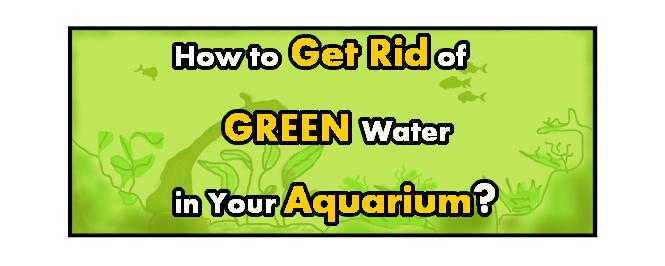
Though some algal blooms in the wild are toxic to wild aquatic life, it is not entirely true for home aquaria.
The answer to this depends on a few factors, and shouldn’t be generalized. The severity of the bloom and the system you’re using play a role.
Small amounts of green are not harmful to the fish or plants in your aquarium water. It’s a fairly natural thing to have free-floating algae spores crop up from time to time in their natural environments.
However, large algal blooms use up oxygen at night time.
Issues arise when there’s an abundance of free-floating phytoplankton in combination with a heterotrophic bacterial bloom in the same tank.
Simply put, when there’s a combination of cloudy water and green water.
Though rarely, this combination of factors can suffocate the fish in the aquarium while their owner is asleep.
Also, using too much water conditioner in fish tanks that are low on oxygen becomes dangerous. And we all tend to overdose on the conditioner in panic mode, thinking it’s to keep our fish safe.
In general, it’s good to know that less than 1% of blooms produce toxins.
The problem with keeping a small phytoplankton population in a tank is that you never know exactly how big it can become.
One day it may be a small green cloud and then you wake up to a nasty pea-green soup taking up the resources for your fish and plants.
Essentially, you’d want to get rid of the green aquarium water as soon as you notice it if you’re worried about your pet fish.
Clearing it up naturally is a somewhat slow process but there are other methods that can help speed things up.
Tested ways to clear the green water in your aquarium up (algae blooms)
Clearing the water up is as simple as improving its biological or mechanical filtration. Fixing biological filtration will restore the balance between microorganisms in the system and proper mechanical filtration will physically remove the ones that are too many.
That being said, to get rid of the green tint of your aquarium water you can:
- Install a UV water sterilizer.
- Manage Nitrate levels.
- Lower the Phosphate levels in the water.
- Set up a fine-fiber filter floss media.
- Clean the substrate.
- Reduce the blue spectrum of your lighting fixture.
- Add an aerator to the aquarium.
Let me discuss the advantages and disadvantages of each method in details.
1. Install a UV water sterilizer.

Here’s a photo collage showing how effective a UV sterilizer can be for clearing up the green tint of the water in a fish tank:
By awmbonke
Using a UV water sterilizer likely is the fastest known method of dealing with unwanted algae blooms in your aquarium.
This method works by bombarding the cells of the algae who pass through the tube of the sterilizer with strong UV radiation, causing mutations directly in their genome.
The mutations, in turn, prevent algae cells from multiplying and employing the nutrients in the water efficiently.
In my experience, UV sterilizers are a highly effective way of waging war on the micro-fauna causing trouble in your fish tank.
Another reason why I recommend this method is that you only target the water column, whereas with a chemical treatment you may or may not cause harm to aquatic plants as well.
Any good UV sterilizer or water calrifier has its own tube with a UV bulb inside and a pump that circulates the infected water through, disinfecting it in the process.
After clearing your tank’s water with one such device you’d just want to follow some simple steps to prevent green water from appearing again.
UV sterilizers is what I personally use when I face similar tank water issues. Even after years of experience in the hobby it still happens to me from time to time.
I got myself a UV sterilizer and I just keep using the same unit over and over on my newer tanks, if needed.
I’ve personally had some very pleasing results with AA Aquarium’s 3-Watt UV Sterilizer for smaller tanks (5 to 20 gallons of water).
You can check that unit at Chewy.com and also Amazon.
The 9-Watt version of the aforementioned UV Sterilizer will likely work best for clearing up water in aquariums of 30 to 55 gallons.
Click here to see the 9-Watt Green Killing Machine at Chewy or here to check it out on Amazon.com.
The UV sterilizer is a beginner-friendly solution, but you do need to know a couple of things before getting one.
A thing you’d want to be aware of is that the power and time needed for the UV to work its magic varies depending on the size of your aquarium.
I’ll save you 5 hours of research then – this is a cheat sheet on selecting the best and most effective UV water sterilizer for your tank’s size and setup. In this artilce you can also see what I’d recommend for tanks larger than 55 gallons.
Give the cheat sheet a skim if you’re into “set it and forget it” solutions and do not have the patience.
The time to success with this water clearing method depends on how heavy the bloom was and how dense the green appears to be. Nailing the right UV sterilizer will clear the green from your aquarium’s water in just about 4 days, from my experience. Other methods mentioned below will likely take upwards of 2 weeks to take any noticeable effect.
Another added benefit of using a UV clarifier is that it works with any type of tank, really, be it freshwater or saltwater.
Anyway, during my early days of aquarium keeping, this was the solution that suited me the best:
One morning, I woke up with my fish tank’s water almost soupy green. Fearing for the life of my fish, I followed quite a few pieces of advice given to me at my local aquarium shop (pure panic).
Nothing seemed to get rid of all the algae though. The green “pea soup” color would disappear and then it’d randomly come back.
Finally, I managed to fully clear the water by getting my hands on a UV sterilizer. It arrived in the mail right on time as I was already desperate and at my wit’s end (with my limited knowledge back then).
Anyhow, as far as permanent solutions go, I’d recommend these water sterilizing filters all day long. My blog’s readers shouldn’t have to go through the headaches I experienced back then…
2. Manage Nitrate levels.

By Hansonzg
If you’re experiencing what seems to be a neverending algal bloom then you’ll need to nip the root cause of this in the bud.
Algae need food to survive, and this comes in the form of high Nitrate levels that result from decomposing fish food and waste.
An overpopulated tank will need additional maintenance and cleaning to ensure no green micro-algae overtakes.
This is because the fish waste is an organic material, which turns to ammonia with time. The ammonia is then reduced by natural processes or by the aquarist themself if it gets too high. In these processes the ammonia gets converted to Nitrate by the nitrifying bacteria in the tank, and algae absolutely love Nitrate.
Technically, algae blooms feed on both Ammonia and Nitrate.
However, ammonia gets converted almost immediately in a cycled tank, whereas nitrates remain in the system unless consumed by plants or exported through water changes.
This is due to a constant microscopic battle between zooplankton and phytoplankton that is occurring within the water.
The former prey on the latter. However, zooplankton tends to be more sensitive to changes in the water balance.
Therefore, constantly changing out the water of your aquarium or doing so in larger amounts can lead to a decreased zooplankton population. This, in turn, can lead to an abundance of phytoplankton which are the spores that make your fish tank’s water green.
This explains why sometimes you may see your aquarium’s water turning green after a hefty water change.
Beyond this, a common folly of new tank owners is that of overfeeding their fish.
It may seem like a non-issue at first glance but any extra food that isn’t eaten ends up sinking to the bottom of the tank.
There, it slowly dissolves thus creating a nutrient-dense water environment, which is fundamental for the development of green algae spores.
A lot of people see this occur in their early days of aquarium keeping and should quickly rectify overfeeding to ensure a healthy habitat.
This should only be a consideration after you’ve resolved the green water issue, but I think here’s the right place to mention it.
Overfeeding can also be avoided with an automatic fish feeder.
I haven’t really done a head-to-head test on all automatic fish feeders, but that’s because I actually ended up nailing the right one from the first time.
I trusted my gut and went for an already established brand in the fishkeeping market (that would be Eheim) and got myself this automatic fish feeder.
In the link, I’m showing you the exact model I got. It has been really reliable in helping me dose the right amount of food for my fish.
3. Lower the Phosphate levels in the water.
Same as all plants, algae thrive in Phosphate-rich waters (PO4). If your water test shows over 1 ppm of Phosphates then you can be sure that these levels are greatly contributing to why your fish tank has become green.
To reduce PO4 in your aquarium water you should know what’s behind it:
- Tap water in older cities;
- Use of carbon filter media without Phosphate absorbers;
- Uncleaned filter;
- Uneaten fish food;
- Fish food rich in PO4;
- kH buffers;
- pH buffers;
- Aquarium salts;
One too many possible culprits if you ask me. In my experience, however, the most likely reason behind elevated Phosphates in the aquarium is tap water.
If you suspect that high PO4 levels are the reason behind the water in your tank turning green, then your next course of action should be to test your tap water.
If this scenario gets confirmed then it may be time to consider a different source of water for your fish tank.
Distilled water, purified water and RO/DI water are all options as long as you remineralize them. Remineralization is the process of adding back the good minerals in the water. Remineralization of filtered water is needed because the purification processes strip both beneficial minerals and harmful particles.
Anyhow, the most cost-efficient method in this situation, in the long run, would be getting your own aquarium RO DI system.
The guide I linked to lists the best RO/DI units to use in a reef tank, but that’s on purpose because you need pristine water when looking after aquarium corals.
Each of the RO/DI systems in there will do a fantastic job at ridding your tap water from Phosphates and other impurities, like Nitrate.
This, in turn, will eliminate the possibility of these impurities causing the water column to become hazy and green.
You just run tap water through the filtration system and add something like Seachem Equilibrium to remineralize it adequately for aquatic life.
4. Set up a fine-fiber filter floss media.
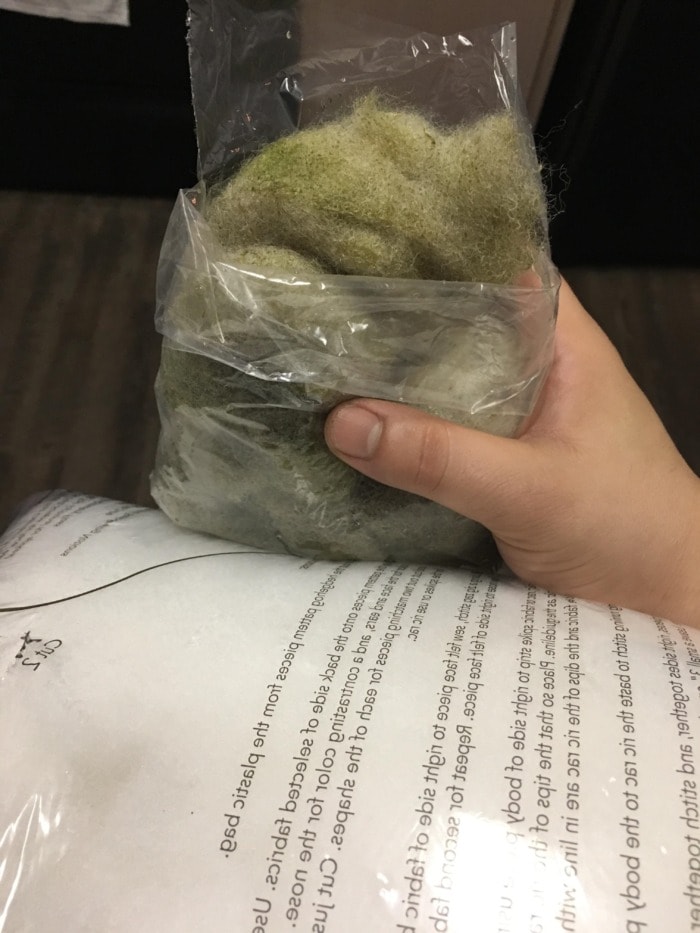
By Spacepoppa
The idea here is to use a fine filter media to strain your water even further than your standard filtration system allows.
This solution works well as a temporary holdover or in conjunction with other methods.
But, be aware that in the case of free-floating algae it will not be enough.
It works well for making cloudy water more clear, but the green tint will likely linger as long as the bloom’s still going on.
That’s because although this filter media will physically remove some of the spores, the remaining ones may continue to multiply.
Anyway, to use filter floss media simply place it somewhere in your filter and be sure to replace it fairly often.
The right filter floss will be really efficient in catching small particles.
This includes microalgae spores, responsible for making the water in your aquarium green.
However, this exact property means that it will build up with particles fairly quickly depending on how dirty the tank is and will stop being effective once clogged.
Think of floss filtration media like this: it’s a way of polishing up the water in your tank, but not a way of fixing the issue that caused the dirty water in the first place.
Still, there certainly is a place for it in aquarium care, especially as a low-budget option to hold over for the green water until a permanent sanitizer is installed.
Anyhow, there’s a catch to selecting the right one, and if you play your cards smart you can get it dirt cheap. Here’s a straightforward guide on everything you’ll need to know about that.
5. Clean the substrate.
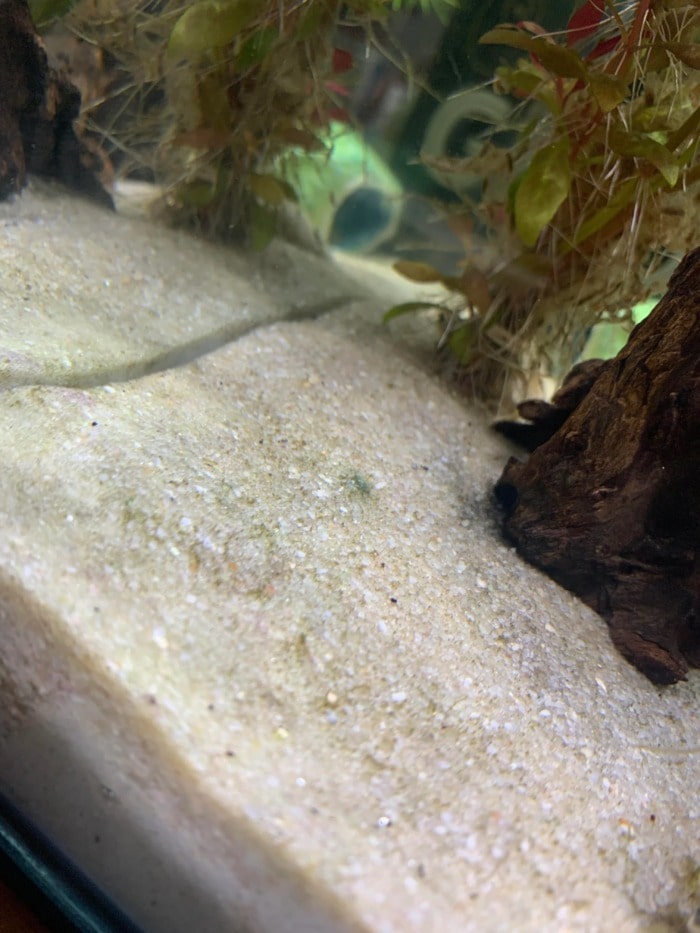
By LukeG543
Over time, the substrate at the bottom of your tank becomes its own ecosystem.
This is normal.
However, if overfeeding or overpopulation with too many fish was an issue in your tank this ecosystem may become filled with heterotrophic bacteria.
Constantly recurring algal bloom and persistent green water can very well be caused by pockets of heterotrophic bacteria. These bacteria may be thriving in the nutrient-dense substrate at the bottom of your aquarium.
Let me explain.
Heterotrophic bacteria feed on nutrients such as organic waste. If not maintained well, small particles of food and fish waste will settle in the substrate and start degrading.
Heterotrophic bacteria feed on leftover food particles and turn them into ammonia and CO2. Both of these byproducts are essential for plant and phytoplankton growth.
Essentially, if you don’t have enough plants in the tank to take up the abundance of nutrients – microalgal spores will bloom and cause the water to become green.
Note that heterotrophic bacterial bloom often goes hand in hand with phytoplankton blooms.
Bacterial blooms cause the water in the aquarium to become cloudy, with a white hue.
This is often the case with new fish tanks right after the nitrogen cycle starts to develop.
Anyway, this method works best in combination with having a UV sterilizer which in turn will eliminate the free-floating bacteria that feed off the nutrients in the water.
6. Reduce the blue spectrum on your aquarium lighting fixture.
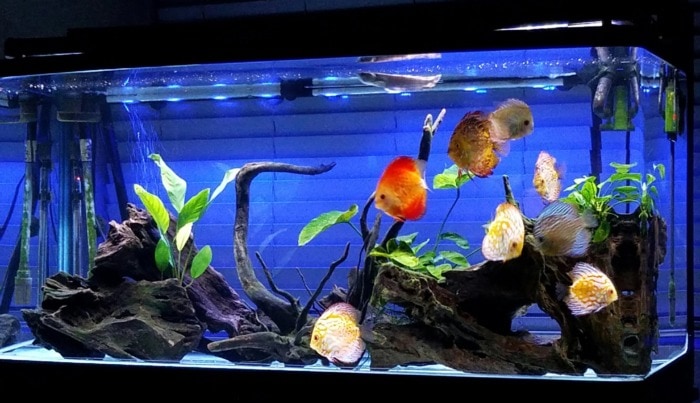
By lloyd_s
An interesting solution to at least limit the development of algal blooms and, consequently, green water in your aquarium is to lower the blue light spectrum that is coming from your lighting.
This can be accomplished through the simple means of changing up the type of light you’re using. An LED setup typically focuses mostly on the red or white light.
If you already have an LED fixture for your aquarium lighting but it lacks a customizable spectrum then, perhaps, it’s time to consider an upgrade.
Since the research on these can be daunting for the newcomer, I think I should mention that I have a pretty detailed article on the subject. It discusses both the best aquarium LED lights and how their spectrum relates to plant growth and photosynthesis.
Other aquatic plants also make use of blue light, but not to the same extent as the algae that caused your fish tank’s water to become green.
This means that by lowering the intensity of blue light diodes (wavelength of 435 to 495 nanometers), you’re limiting the growth of algae. Not only that – by doing so you’re also bolstering the light that the “good” aquatic plants in your tank enjoy.
Anyway, I wouldn’t recommend this as a cure for algae necessarily, but if the lighting was the problem it is an excellent preventative measure. Lowering the blue light of your LED fixtures will help the overall health of your aquarium’s water without having to buy any additional equipment.
Look into light spectrums and how they affect plants in aquariums in the article I linked you to above.
The light spectrum is an often overlooked aspect of aquarium management that I rarely see mentioned in online literature. And this is especially true when it comes to the phytoplankton blooms, responsible for making the water green.
Author’s Note: Some LED aquarium fixtures have a “night mode”, or actinic blue light, which is supposed to be left on during the night purely for aesthetic reasons. If yours has that you should likely consider turning it off. Removing the actinic blue light from your LED lights’ schedule altogether can help with clearing up the water in your fish tank by a large margin.
7. Add an aerator to the aquarium.
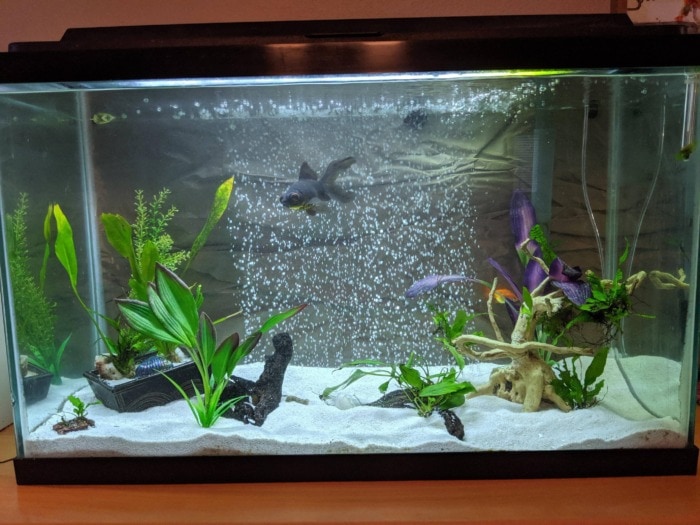
By kindellyf
For the processes listed in my previous section, you may want to add an aerator to your aquarium.
This is not a direct solution that will get your aquarium rid of green water. It is rather a protective measure for your fish until the balance in the ecosystem is restored.
Both of hpytoplankton and heterotrophic bacteria require huge amounts of oxygen in the water.
Why am I recommending an aerator then, wouldn’t that help them thrive?
Well, guess who also needs oxygen to survive – your fish.
During a bacterial and algae bloom the demands for oxygen in the affected aquarium rise. Your fish are essentially competing with the micro-flora and fauna in the water. Moreover, this effect is multiplied during night hours.
Plants and algae produce oxygen during the day, and in the process turn light energy into sugars.
During the night, however, a process called respiration takes place in the plants, and it employs said sugars for cell food.
You could say that respiration is the opposite of photosynthesis. Turning sugars into cell energy actually uses up the oxygen in the water.
All of this means, that if your aquarium already has green water, during night hours your fish may be competing for oxygen with the phytoplankton.
Though this is not always the case, in more extreme cases of algae bloom your less hardy fish species may suffocate.
By adding an aerator you make sure there’s enough oxygen for everyone in the fish tank and you’ll have peace of mind while fighting off the green water.
How to stop your aquarium water from ever turning green again?
These should not be used as a cure for algae once it has occurred, but more of a preventative measure to keep a healthy balance in your aquarium for the future.
To prevent the water in your fish tank from going green again, you can:
- Run a UV sterilizer for 4 hours every other day
- Better control how much you feed your fish
- Introduce algae-eating snails, shrimp, or fish to your tank
- Minimize direct sunlight on the fish tank
- Grow healthy plants in your aquarium that take resources away from the algae
- Raise water flea cultures
All of these methods will permanently prevent your aquarium water from going green.
Some are more effective than others and I will discuss each below.
1. Run a UV sterilizer for 4 hours every other day
Setting up and running a UV water filter will never allow an imbalance of harmful organisms, not only phytoplankton.
Since it’s very effective, this type of aquarium equipment is very popular among freshwater and saltwater fishkeepers alike.
It also prevents a number of diseases such as Ich, for example, which are difficult to get rid of once established.
2. Stop overfeeding
Overfeeding is a common way humans contribute to green aquarium water.
Too much food eventually ends up in the water column, be it as fish poop or uneaten leftovers. These start releasing organics in the water, which the algae spores use to feed on.
Even though your pet fish will always seem hungry you should not overdo it when feeding them.
Fish are wild animals and as such are used to constantly looking for food to survive.
Carnivorous fish such as Bettas and other Gouramis will need to be fed once a day. On the other hand, you’d want to feed omnivorous or herbivorous fish like the goldfish, livebearers and some plecos 2 to 3 times a day, in small portions.
I’ve written a good detailed article on how much you should feed your pet fish to avoid overfeeding which I recommend you check out.
3. Introduce algae eating snails, shrimp, or fish to your tank
This is another preventative measure that can go well with other algal combatting actions.
These little guys are quite effective at cleaning up any algae growth that is sticking to the walls of the tank, or even hair algae. However, don’t expect them to do the whole job for you.
If you’re currently dealing with a green bloom, this is not the solution you’re looking for.
Algae eaters will be affected just like anything else in the tank and they should only be added to an already healthy tank or one that has macro-algae issues.
That being said, algae eaters are constantly on the lookout for globules of algae to eat up.
Chances are they have a better eye than you for it.
Ramshorn Snails and Bristlenose plecos are popular additions to any freshwater system while tangs (or surgeonfish) and Banded Trochus Snails are some of the go-to algae eaters for saltwater and reef tanks.
These creatures really do a great job at spot-cleaning the aquarium. This solution is probably the most fun in my eyes, I mean, who doesn’t want more creatures in their ecosystem?
Here’s a list of the most efficient algae-cleaning aquatic critters.
Give it a skim as there are some pretty interesting and cool-looking animals included.
4. Minimize direct sunlight on the fish tank
Sunlight provides plenty of energy to plants, especially in a closed system such as our beloved fish tanks.
However, algal spores can quickly take advantage of the extra energy and start multiplying aggressively.
This is a VERY common mistake for the new fishkeeper, but it’s also the easiest to fix.
Just place your tank out of direct sunlight to avoid the possibility of green water.
One of the reasons ponds are especially susceptible to green water from algae is their daily exposure to direct sunlight.
5. Grow Healthy Plants in your Aquarium
Surprisingly, the solution for a lot of tanks is to actually add more plants.
Allelopathy, the idea that certain plants release chemicals that combat other plants including algae, is sometimes given credit for why their addition seems to help so much.
There is some amount of credit to this in studies, but the actual reason this works is much simpler:
By adding more fast-growing plants to your aquarium you make sure that a lot of the free resources are taken up. These include excess Nitrate and Phosphate levels, that algae and phytoplankton would otherwise use to bloom.
Floating live plants grow astonishingly fast and are known as “nutrient sponges” in the hobby. Visit this page to skim through the best selection of these for your freshwater aquarium.
This is, again, not necessarily useful for green fish tank water but it will stop blooms from happening in the first place.
6. Raise water flea cultures
Water fleas prey on excessive phytoplankton in an aquarium.
Having a healthy colony of water fleas will keep the algal spores in check, crushing the possibility of green water in advance.
On top of that, they have another beneficial impact on aquarium ecosystems.
They are super nutritious and most fish have a taste for them. This could significantly reduce the need for feeding in general, once the culture has established itself.
You can find water fleas in most pet stores, where they are commonly known as Daphnia.
If you introduce Daphnia to aquarium water with a green tint it will take weeks before any visually noticeable effect takes place.
The green light to do something about nasty aquarium water
These methods should take care of just about any problematic algae bloom situation you might find yourself in.
Following this guide properly will indeed let you get rid of unsightly green water issues in your aquarium.
In a general sense, these methods will help you create a healthier ecosystem for your fish and plants to live in.
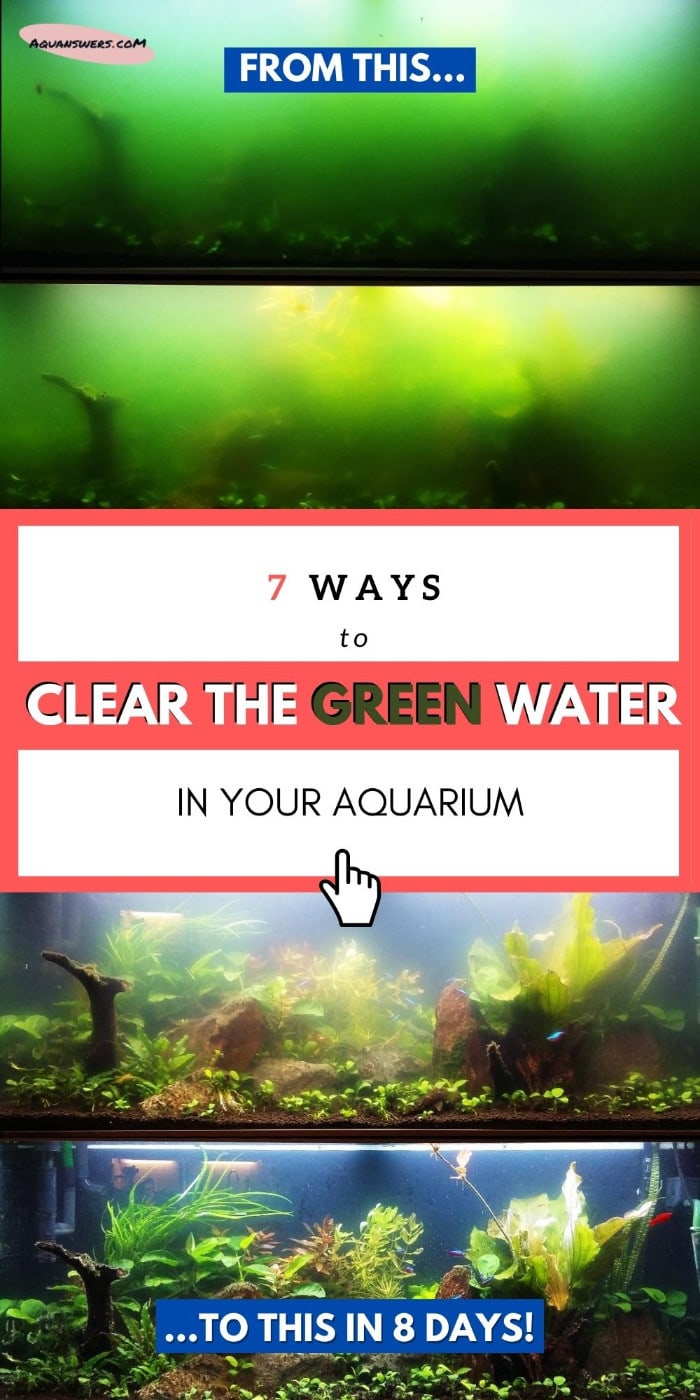
If you need more advice you can leave me a comment below and I’ll make sure to quickly respond.

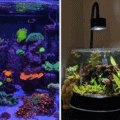
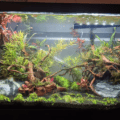



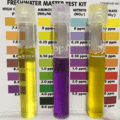


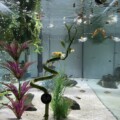

22 thoughts on “How to get rid of green aquarium water (algae bloom)?”